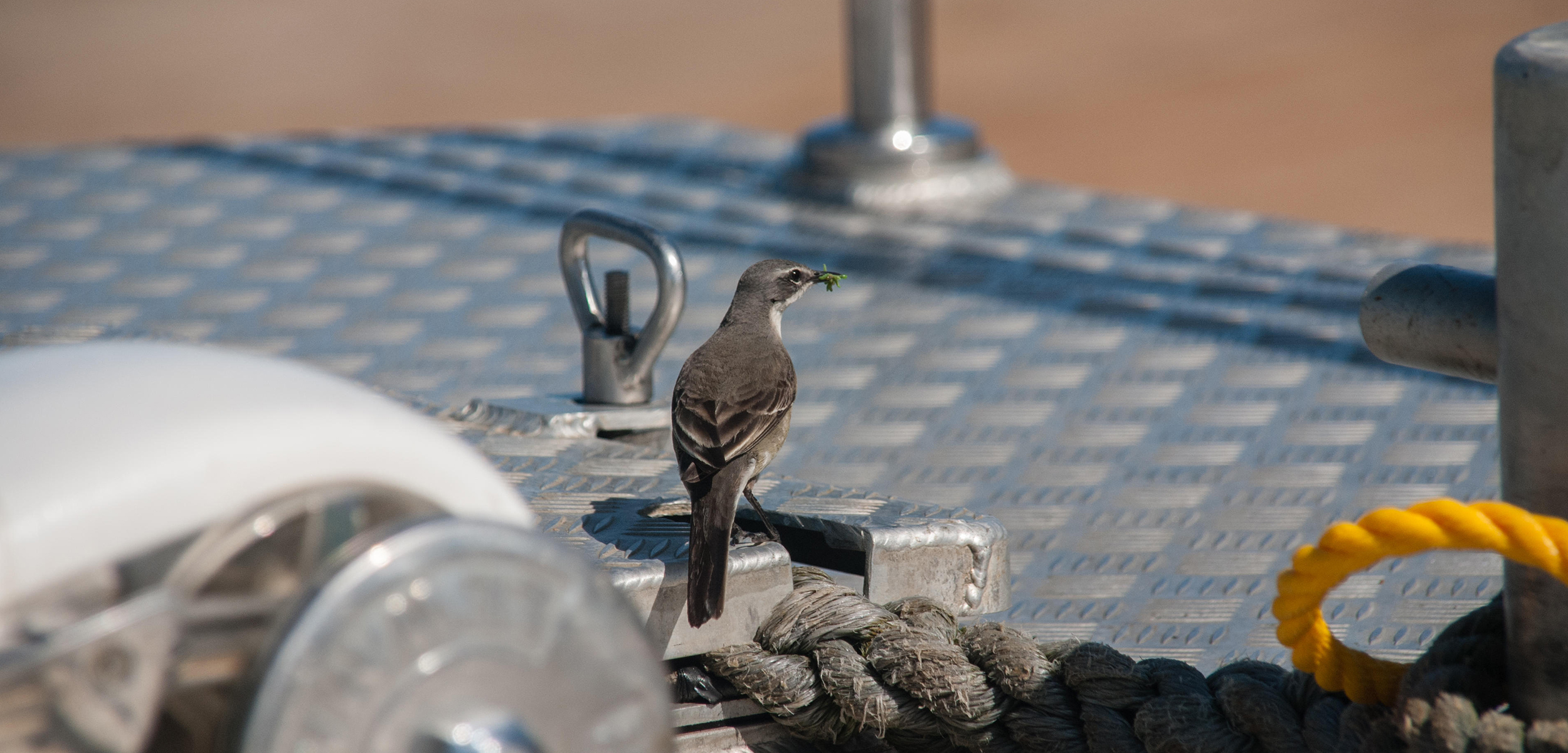
Plenty of bird species are well habituated to the human presense in cities. So catching a passing ship is hardly a stretch and yes, we are going to see colonizations take place.
We were just not looking for it.
It is another variable we should pay attention to. Hzarmless now but possibly not in the long term.
With Ships, Birds Find an Easier Way to Travel
Why fly all the way across the ocean when you can chill out by the pool?
by Ute Eberle
March 16, 2023 | 800 words, about 4 minute
Birds are a decently common sight on ships’ decks. But could birds be adapting to a new reality of assisted migration? Photo by Anna Phillips/Alamy Stock Photo
https://hakaimagazine.com/news/with-ships-birds-find-an-easier-way-to-travel/?
Last fall, hundreds of birders rushed to Bryher, a tiny island off the coast of Cornwall, England. They came to see a Blackburnian warbler, a bird with a flaming orange throat and a high-pitched, trilled song. Blackburnian warblers are hardly ever seen in the United Kingdom—their home is 4,800 kilometers away in the pine forests of North America. Though they’re adept fliers, these birds typically overwinter in South America. So how did the bird get to Bryher?
Blackburnian warblers are small. Each weighs about as much as four pennies. It’s incredibly unlikely this vagrant warbler could have flown to Bryher under its own steam. Equally unlikely, says Roger Lederer, an ornithologist emeritus at California State University, Chico, is that the bird climbed eight or more kilometers into the sky and was blown off course by the jet stream. According to Lederer, this leaves just one possibility: the warbler took a boat.
Birds are often unexpected stowaways on ships around the world. Freighter crews have long told stories of sparrows and nightjars, owls, and herons settling on their boats’ decks, some for minutes, others for days. There’s video footage of a whole flock of starlings landing on a fishing boat in the North Sea. And after conservationists tagged a young osprey in Scotland, they watched with bemusement as the bird’s tracking signal showed its voyage to Spain involved riding on a cargo ship. The bird switched to a second vessel mid-journey before finishing the trip on its own.
The phenomenon has a name: ship-assisted migration. But few researchers paid much attention to how frequently birds hitchhike on ships—at least in a systematic way—until Maurizio Sarà took a month-long research cruise in the Mediterranean.
In 2021, Sarà, a zoologist at the University of Palermo in Italy, planned to observe dolphins, turtles, and other marine species. But he kept noticing terrestrial birds, like wagtails and wheatears, landing on the boat. He started keeping track. On average, he saw three birds arrive on the boat every day. Their median stopping time was 42 minutes but several stayed overnight. Extrapolating from his observations to the thousands of ships that travel the Mediterranean every day and the billions of birds that cross the sea during their migrations, Sarà estimates that as many as four million birds may be taking rest stops on boats during their spring migrations across the Mediterranean.
Something similar probably happens on other oceans as well, he thinks. Globally, some 4,000 bird species migrate, with many battling headwinds or storms as they travel thousands of kilometers. Where their voyages lead across oceans, the birds must go without water and food for long stretches. They rest on islands to refuel or wait out bad weather. Islands, however, are more scarce than boats.
Even counting only the commercial shipping fleet, around 90,000 ships are regularly crisscrossing the world’s waters. Sarà speculates that birds developed a new migration strategy for this modern era, one where they use the abundant freighters, tankers, and cruise ships as stepping stones on transcontinental flights. Even a short stop “can be enough to avoid the most tiring part of traversing a low atmospheric pressure cell, or to recover from the physiological stress that the migratory flight entails,” Sarà writes in the recent paper.
Alexander Lees, a conservation biologist at Manchester Metropolitan University in England who wasn’t involved in the research, says ship-assisted migration “is something that would be absolutely worth studying more.”
While Lees thinks Sarà’s estimate of four million birds using ships on their voyages across the Mediterranean is somewhat high, he has noticed that the Records Committee of the British Ornithologists’ Union, on which he sits, gets two or three reports a year that birds such as northern mockingbirds or brown thrashers have been sighted in the United Kingdom, even though they’re neither native to the area nor adapted for long-distance migrations. In about half of these cases, Lees says, the committee suspects the bird has arrived with the help of a boat.
It’s surprising how well birds can survive even entire ocean crossings on deck, Lees says. “Grain eaters tend to get handouts from people, such as crisps. And insectivores may find windblown insects. Raptors use the boat as a perch to hunt seabirds,” he says.
Every so often, this could allow a species to colonize a new region. The best evidence of ship-assisted colonization comes from a bird that doesn’t usually migrate at all: the Indian house crow. In recent years, so many of these birds stowed away on boats to the Netherlands from their native South Asia that they’ve established a breeding colony near Rotterdam.
None of this made the Blackburnian warbler on Bryher any less sensational. But there may come a day when the sight of a flame-throated bird on the island is much more common.
No comments:
Post a Comment